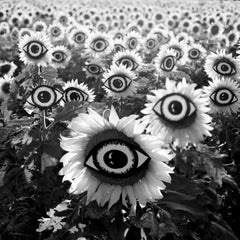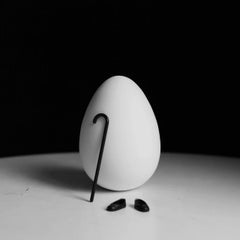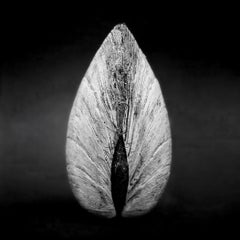Olha Stepanian Still-life Photography
Ukrainian
Olga Stepanian of Cherkasy – a city in central Ukraine – was supposed to be a seamstress but constantly thought of photography. At one point in her life, she decided that she could no longer remain silent. From behind the lens, she tells stories that do not seem to be too influenced by and are not necessarily representative of her cultural setting. “I don’t think my location affects my work much,” she says. Olga likes the fashion and portrait photographer Rodney Smith (born 1947) – famous for his minimalistic and whimsical art, Sally Mann (born 1951) – known for her provocative shots of the naked and the dead and Henri Cartier-Bresson (1908-2004) – a pioneer of candid and street photography. These are the figures she tried to study in-depth. She made an effort to understand the thoughts and intentions behind the moments they would capture. Olga’s present portfolio is made up of highly cinematic black and white shots that quietly explore a variety of feelings and situations – loneliness and estrangement, bondage and freedom, restlessness, even gossip. A young girl is suspended limply between two ladders on a barren piece of land. Annoying and frightening human hands emerge from within the cracks of a white wall, urgently wanting to seize and stifle anything within reach. An individual so feels the crushing force of the demands of daily life that they retreat into a cocoon of bandages.
to
4
2
Overall Width
to
Overall Height
to
6
6
6
2
2
6
6
372
270
255
130
128
5
1
Artist: Olha Stepanian
"Eclipsed Visions" Figurative Photography 24" x 24" in Ed 1/15 by Olha Stepanian
By Olha Stepanian
Located in Culver City, CA
"Eclipsed Visions" Figurative Photography 24" x 24" in Ed 1/15 by Olha Stepanian
Printed on Epson Professional Paper
Signed and numbered by the artist
Not framed. Ships in a tub...
Category
21st Century and Contemporary Contemporary Olha Stepanian Still-life Photography
Materials
Archival Paper
"Women" Black & White Photography 24" x 24" in Edition 2/15 by Olha Stepanian
By Olha Stepanian
Located in Culver City, CA
"Women" Black & White Photography 24" x 24" in Edition 2/15 by Olha Stepanian
Printed on Epson Professional Paper
Signed and numbered by the artist
Not framed. Ships in a tube. ...
Category
21st Century and Contemporary Contemporary Olha Stepanian Still-life Photography
Materials
Archival Paper
"I am" Black & White Photography 31" x 31" inch Edition of 7 by Olha Stepanian
By Olha Stepanian
Located in Culver City, CA
"I am" Black & White Photography 31" x 31" inch Edition of 7 by Olha Stepanian
Printed on Epson Professional Paper
Signed and numbered by the artist
Not framed. Ships in a t...
Category
21st Century and Contemporary Contemporary Olha Stepanian Still-life Photography
Materials
Archival Paper
"Women" Black & White Photography 31" x 31" in Edition of 7 by Olha Stepanian
By Olha Stepanian
Located in Culver City, CA
"Women" Black & White Photography 31" x 31" in Edition of 7 by Olha Stepanian
Printed on Epson Professional Paper
Signed and numbered by the artist
Not framed. Ships in a tube. ...
Category
21st Century and Contemporary Contemporary Olha Stepanian Still-life Photography
Materials
Archival Paper
"Peekaboo" Black & White Photography 24" x 24" inch Ed. of 15 by Olha Stepanian
By Olha Stepanian
Located in Culver City, CA
"Peekaboo" Black & White Photography 24" x 24" inch Ed. of 15 by Olha Stepanian
Printed on Epson Professional Paper
Signed and numbered by the artist
Not framed. Ships in a tube...
Category
21st Century and Contemporary Contemporary Olha Stepanian Still-life Photography
Materials
Archival Paper
"I am" Black & White Photography 24" x 24" inch Edition of 15 by Olha Stepanian
By Olha Stepanian
Located in Culver City, CA
"I am" Black & White Photography 24" x 24" inch Edition of 15 by Olha Stepanian
Printed on Epson Professional Paper
Signed and numbered by the artist
Not framed. Ships in a tube...
Category
21st Century and Contemporary Contemporary Olha Stepanian Still-life Photography
Materials
Archival Paper
Related Items
Clam 02 - Signed limited edition Contemporary art print, Black white square
By Ian Sanderson
Located in Sant Cugat del Vallès, Barcelona
Clam 02- Signed limited edition archival pigment print - Edition of 5
This image was captured on film in 1984.
The negative was scanned creating a digital file which was then p...
Category
1980s Contemporary Olha Stepanian Still-life Photography
Materials
Photographic Film, Archival Paper, Photographic Paper, Black and White, ...
$2,956
H 15.75 in W 15.75 in D 0.08 in
FlowerHead - Signed limited edition still life print, botanical close-up
By Ian Sanderson
Located in Sant Cugat del Vallès, Barcelona
An original signed archival pigment print on Hahnemühle Photo Rag® Baryta 315 gsm paper by Scottish artist Ian Sanderson (1951- 2020) titled ‘FlowerHead ‘ who was captured on film in...
Category
1980s Contemporary Olha Stepanian Still-life Photography
Materials
Photographic Film, Archival Paper, Photographic Paper, Black and White, ...
$2,956
H 19.69 in W 13.51 in D 0.08 in
"Gas & Gasoline", 2007
By Ian Gittler
Located in Hudson, NY
Ian Gittler’s Motor Art series-photographs of century-old engine parts, gears, sparkplugs, and brand tags-offers respite from the digital fetishism, overexpo...
Category
21st Century and Contemporary Contemporary Olha Stepanian Still-life Photography
Materials
Archival Paper, Pigment
"Cummins Steam Pump", 2007
By Ian Gittler
Located in Hudson, NY
Ian Gittler’s Motor Art series-photographs of century-old engine parts, gears, sparkplugs, and brand tags-offers respite from the digital fetishism, overexposure and one-hundred-forty-character bursts of communication that seem to define our era. Gittler is no luddite, he loves his iPhone. But these images, often obscuring the objects beyond identification, take unsentimental pleasure in elements of weight, ground, volume and permanence that are more closely associated with a bygone heyday of industrialization.
These photographs are about a tangible physical experience, about moving parts. Gittler’s expert printing-his ability to see the potential in a frame and employ the techniques necessary to articulate that vision on paper-brings the work to life.
There’s wit in the brand iconography and a documentary component, but Gittler resists prescribing interpretations, saying subtext isn’t the point. His use of extremely shallow depth of field, intense contrast and exploded grain is muscular and poetic. But subtext is relevant.
Although Robin Rice first approached Ian Gittler about his vector-based art on photo paper, the gallerist challenged him to create a series of photographs with that kind of machismo. As a native New Yorker who was marched through the halls of MOMA as a toddler, Gittler’s inspiration-his idea of macho-has less to do with cowboys and racecar drivers than with Franz Kline brushstrokes and modernist design. For Gittler, macho means the maximum amount of black ink that can lie across a sheet of photo paper. That kind of force. He narrowed his field of view for this series-often to a centimeter or two-in order to achieve a purely visual, visceral response.
Gittler titled the work Motor Art in tribute to the 1934 Museum of Modern Art exhibit, Machine Art. Upon its sixtieth anniversary, Phillip Johnson wrote of the show (and of his own essay for its original opening), “The thrust was clear: anti-handicraft, industrial methods alone satisfied our age; Platonic dreams of perfection were the ideal.”
Ian Gittler photographs, draws, writes, and makes music. He has created album covers for Willie Nelson, Roy Hargrove...
Category
21st Century and Contemporary Contemporary Olha Stepanian Still-life Photography
Materials
Archival Paper, Pigment
"Mianus Motor Works", 2007
By Ian Gittler
Located in Hudson, NY
Ian Gittler’s Motor Art series-photographs of century-old engine parts, gears, sparkplugs, and brand tags-offers respite from the digital fetishism, overexp...
Category
21st Century and Contemporary Contemporary Olha Stepanian Still-life Photography
Materials
Archival Paper, Pigment
Clam - Signed limited edition nature fine art print, Black white photo, Graphic
By Ian Sanderson
Located in Sant Cugat del Vallès, Barcelona
Clam - Signed limited edition archival pigment print, Sepia tone - Edition of 5
This image was captured on film in 1984.
The negative was scanned creating a digital file which...
Category
1980s Contemporary Olha Stepanian Still-life Photography
Materials
Photographic Film, Archival Paper, Photographic Paper, Black and White, ...
$2,205 Sale Price
25% Off
H 20.48 in W 14.77 in D 0.08 in
"Speed Lever", 2010
By Ian Gittler
Located in Hudson, NY
Ian Gittler’s Motor Art series-photographs of century-old engine parts, gears, sparkplugs, and brand tags-offers respite from the digital fetishism, overexposure and one-hundred-forty-character bursts of communication that seem to define our era. Gittler is no luddite, he loves his iPhone. But these images, often obscuring the objects beyond identification, take unsentimental pleasure in elements of weight, ground, volume and permanence that are more closely associated with a bygone heyday of industrialization.
These photographs are about a tangible physical experience, about moving parts. Gittler’s expert printing-his ability to see the potential in a frame and employ the techniques necessary to articulate that vision on paper-brings the work to life. There’s wit in the brand iconography and a documentary component, but Gittler resists prescribing interpretations, saying subtext isn’t the point. His use of extremely shallow depth of field, intense contrast and exploded grain is muscular and poetic. But subtext is relevant.
Although Robin Rice first approached Ian Gittler about his vector-based art on photo paper, the gallerist challenged him to create a series of photographs with that kind of machismo. As a native New Yorker who was marched through the halls of MOMA as a toddler, Gittler’s inspiration-his idea of macho-has less to do with cowboys and racecar drivers than with Franz Kline brushstrokes and modernist design. For Gittler, macho means the maximum amount of black ink that can lie across a sheet of photo paper. That kind of force. He narrowed his field of view for this series-often to a centimeter or two-in order to achieve a purely visual, visceral response.
Gittler titled the work Motor Art in tribute to the 1934 Museum of Modern Art exhibit, Machine Art. Upon its sixtieth anniversary, Phillip Johnson wrote of the show (and of his own essay for its original opening), “The thrust was clear: anti-handicraft, industrial methods alone satisfied our age; Platonic dreams of perfection were the ideal.”
Ian Gittler photographs, draws, writes, and makes music. He has created album covers for Willie Nelson, Roy Hargrove...
Category
21st Century and Contemporary Contemporary Olha Stepanian Still-life Photography
Materials
Archival Paper, Pigment
"Trip Hammer", 2010
By Ian Gittler
Located in Hudson, NY
Ian Gittler’s Motor Art series-photographs of century-old engine parts, gears, sparkplugs, and brand tags-offers respite from the digital fetishism, overexposure and one-hundred-forty-character bursts of communication that seem to define our era. Gittler is no luddite, he loves his iPhone. But these images, often obscuring the objects beyond identification, take unsentimental pleasure in elements of weight, ground, volume and permanence that are more closely associated with a bygone heyday of industrialization.
These photographs are about a tangible physical experience, about moving parts. Gittler’s expert printing-his ability to see the potential in a frame and employ the techniques necessary to articulate that vision on paper-brings the work to life. There’s wit in the brand iconography and a documentary component, but Gittler resists prescribing interpretations, saying subtext isn’t the point. His use of extremely shallow depth of field, intense contrast and exploded grain is muscular and poetic. But subtext is relevant.
Although Robin Rice first approached Ian Gittler about his vector-based art on photo paper, the gallerist challenged him to create a series of photographs with that kind of machismo. As a native New Yorker who was marched through the halls of MOMA as a toddler, Gittler’s inspiration-his idea of macho-has less to do with cowboys and racecar drivers than with Franz Kline brushstrokes and modernist design. For Gittler, macho means the maximum amount of black ink that can lie across a sheet of photo paper. That kind of force. He narrowed his field of view for this series-often to a centimeter or two-in order to achieve a purely visual, visceral response.
Gittler titled the work Motor Art in tribute to the 1934 Museum of Modern Art exhibit, Machine Art. Upon its sixtieth anniversary, Phillip Johnson wrote of the show (and of his own essay for its original opening), “The thrust was clear: anti-handicraft, industrial methods alone satisfied our age; Platonic dreams of perfection were the ideal.”
Ian Gittler photographs, draws, writes, and makes music. He has created album covers for Willie Nelson, Roy Hargrove...
Category
21st Century and Contemporary Contemporary Olha Stepanian Still-life Photography
Materials
Archival Paper, Pigment
"Pressure Gauge", 2007
By Ian Gittler
Located in Hudson, NY
Ian Gittler’s Motor Art series-photographs of century-old engine parts, gears, sparkplugs, and brand tags-offers respite from the digital fetishism, overexposure and one-hundred-forty-character bursts of communication that seem to define our era. Gittler is no luddite, he loves his iPhone. But these images, often obscuring the objects beyond identification, take unsentimental pleasure in elements of weight, ground, volume and permanence that are more closely associated with a bygone heyday of industrialization.
These photographs are about a tangible physical experience, about moving parts. Gittler’s expert printing-his ability to see the potential in a frame and employ the techniques necessary to articulate that vision on paper-brings the work to life.
There’s wit in the brand iconography and a documentary component, but Gittler resists prescribing interpretations, saying subtext isn’t the point. His use of extremely shallow depth of field, intense contrast and exploded grain is muscular and poetic. But subtext is relevant.
Although Robin Rice first approached Ian Gittler about his vector-based art on photo paper, the gallerist challenged him to create a series of photographs with that kind of machismo. As a native New Yorker who was marched through the halls of MOMA as a toddler, Gittler’s inspiration-his idea of macho-has less to do with cowboys and racecar drivers than with Franz Kline brushstrokes and modernist design. For Gittler, macho means the maximum amount of black ink that can lie across a sheet of photo paper. That kind of force. He narrowed his field of view for this series-often to a centimeter or two-in order to achieve a purely visual, visceral response.
Gittler titled the work Motor Art in tribute to the 1934 Museum of Modern Art exhibit, Machine Art. Upon its sixtieth anniversary, Phillip Johnson wrote of the show (and of his own essay for its original opening), “The thrust was clear: anti-handicraft, industrial methods alone satisfied our age; Platonic dreams of perfection were the ideal.”
Ian Gittler photographs, draws, writes, and makes music. He has created album covers for Willie Nelson, Roy Hargrove...
Category
21st Century and Contemporary Contemporary Olha Stepanian Still-life Photography
Materials
Archival Paper, Pigment
"Marston Excelsior", 2007
By Ian Gittler
Located in Hudson, NY
Ian Gittler’s Motor Art series-photographs of century-old engine parts, gears, sparkplugs, and brand tags-offers respite from the digital fetishism, overexpo...
Category
21st Century and Contemporary Contemporary Olha Stepanian Still-life Photography
Materials
Archival Paper, Pigment
"Knotted Wire Brush", 2010
By Ian Gittler
Located in Hudson, NY
Ian Gittler’s Motor Art series-photographs of century-old engine parts, gears, sparkplugs, and brand tags-offers respite from the digital fetishism, overexposure and one-hundred-forty-character bursts of communication that seem to define our era. Gittler is no luddite, he loves his iPhone. But these images, often obscuring the objects beyond identification, take unsentimental pleasure in elements of weight, ground, volume and permanence that are more closely associated with a bygone heyday of industrialization.
These photographs are about a tangible physical experience, about moving parts. Gittler’s expert printing-his ability to see the potential in a frame and employ the techniques necessary to articulate that vision on paper-brings the work to life. There’s wit in the brand iconography and a documentary component, but Gittler resists prescribing interpretations, saying subtext isn’t the point. His use of extremely shallow depth of field, intense contrast and exploded grain is muscular and poetic. But subtext is relevant.
Although Robin Rice first approached Ian Gittler about his vector-based art on photo paper, the gallerist challenged him to create a series of photographs with that kind of machismo. As a native New Yorker who was marched through the halls of MOMA as a toddler, Gittler’s inspiration-his idea of macho-has less to do with cowboys and racecar drivers than with Franz Kline brushstrokes and modernist design. For Gittler, macho means the maximum amount of black ink that can lie across a sheet of photo paper. That kind of force. He narrowed his field of view for this series-often to a centimeter or two-in order to achieve a purely visual, visceral response.
Gittler titled the work Motor Art in tribute to the 1934 Museum of Modern Art exhibit, Machine Art. Upon its sixtieth anniversary, Phillip Johnson wrote of the show (and of his own essay for its original opening), “The thrust was clear: anti-handicraft, industrial methods alone satisfied our age; Platonic dreams of perfection were the ideal.”
Ian Gittler photographs, draws, writes, and makes music. He has created album covers for Willie Nelson, Roy Hargrove...
Category
21st Century and Contemporary Contemporary Olha Stepanian Still-life Photography
Materials
Archival Paper, Pigment
"Oil Distribution Manifold", 2007
By Ian Gittler
Located in Hudson, NY
Ian Gittler’s Motor Art series-photographs of century-old engine parts, gears, sparkplugs, and brand tags-offers respite from the digital fetishism, overexp...
Category
21st Century and Contemporary Contemporary Olha Stepanian Still-life Photography
Materials
Archival Paper, Pigment
Previously Available Items
"Women" Black & White Photography 24" x 24" in Edition of 15 by Olha Stepanian
By Olha Stepanian
Located in Culver City, CA
"Women" Black & White Photography 24" x 24" in Edition of 15 by Olha Stepanian
Printed on Epson Professional Paper
Signed and numbered by the artist
Not framed. Ships in a tube....
Category
21st Century and Contemporary Contemporary Olha Stepanian Still-life Photography
Materials
Archival Paper
Olha Stepanian still-life photography for sale on 1stDibs.
Find a wide variety of authentic Olha Stepanian still-life photography available for sale on 1stDibs. You can also browse by medium to find art by Olha Stepanian in archival paper, paper and more. Much of the original work by this artist or collective was created during the 21st century and contemporary and is mostly associated with the contemporary style. Not every interior allows for large Olha Stepanian still-life photography, so small editions measuring 24 inches across are available. Olha Stepanian still-life photography prices can differ depending upon medium, time period and other attributes. On 1stDibs, the price for these items starts at $1,350 and tops out at $1,750, while the average work can sell for $1,550.








